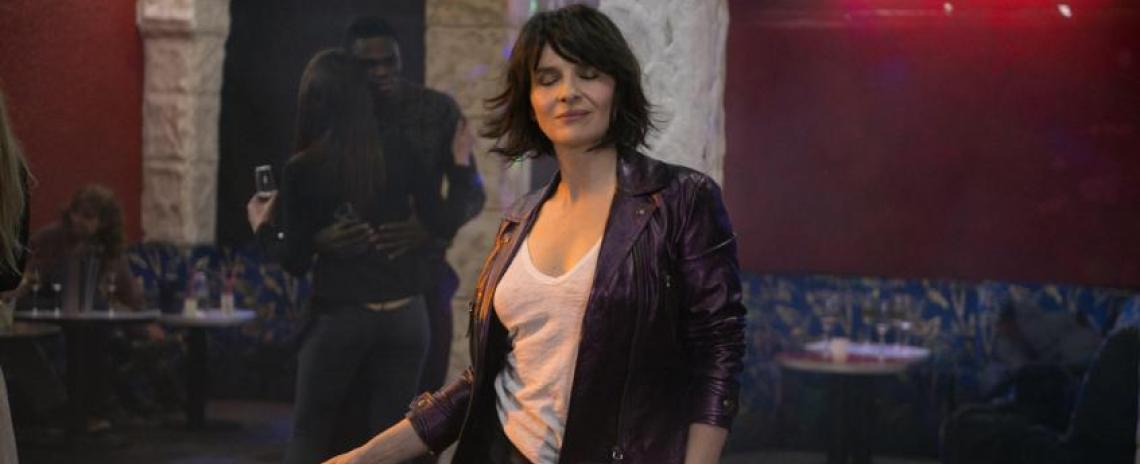In Claire Denis’ last film, the director left viewers with the most unsettling images of her career. Her 2013 feature Bastards was a time-hopping narrative of betrayal and murder, culminating in the reveal of an incestual rape. While not exactly a change of pace from her ultra-violent revisionist vampire tale, Trouble Every Day (2001), or her apocalyptic critique of colonialism, White Material (2010), Bastards was still one of Denis’ most brutal works — a dirge for decency in the modern world. By contrast, when the first reactions to Let the Sunshine In (Un beau soleil intérieur) were filed from the 2017 Cannes Film Festival, critics referred to it as “Denis lite,” a frothy confection about an older woman and her travails in love. It seemed that the chronicler of the lower depths of humanity had gone soft.
Although Sunshine does indeed resemble the romantic dramedy in distilled form, the film is a mature work concerning the interiority of a feminine psyche and the forces that shape it. As a portrait of adult solitude, it’s remarkably candid about its protagonist’s mixture of sexual desire and woozy romanticism. The film is as complex of any of Denis’ previous works and as easy to digest as Ernst Lubitsch feature from the Golden Age of Hollywood. The script is loosely based on French philosopher Roland Barthes’ A Lover's Discourse: Fragments, a 1977 book of interconnected tales about young lovers. Denis and co-writer Christine Angot cohere the fragmentation around a middle-aged artist, Isabelle (Juliette Binoche), a recent divorcee whose rotating cast of male lovers leaves her in various states of relationship purgatory. These couplings dictate the film’s structure, with disparate threads becoming increasingly entangled before knotting together in a swoon-worthy upbeat ending.
Sunshine borrows as much from Barthes as it does from it from its leading lady’s persona. It’s a showcase role much like the stage and screen actress Binoche portrayed in Olivier Assayas’ The Clouds of Sils Maria (2014), and she realizes Isabelle’s anxieties with her trademark deep reserves of humanity. The opening scene is of fully nude Isabelle engaging in unfulfilling sex with one of her partners, the emotionally stunted banker Vincent (Xavier Beauvois). She pacifies his performance before he launches into an inappropriate conversation about her past lovers. The scene is a glimpse of the push-and-pull that men exert on Isabelle, laying out reasoning for the financially and artistically successful woman to engage in a monomaniacal search for a harmonious relationship. Isabelle oscillates between charming and aloof, relaxed and anxious, and Binoche performs each note with expert precision while maintaining a naturalistic ease. She also understands that the comedy in Sunshine — there are, in fact, plenty of laughs — comes from Isabelle’s inability to communicate her feelings to her partners. Her strife can be located in the roles the men force on her, as well as in her own desires. She often finds herself in negative feedback loops with her partners, with escalating frustration leading to exhaustion. After dinner with her beer-swilling married actor boyfriend (Nicolas Duvauchelle), she tells him that they have wasted time: “I feel like we said nothing. We just said the opposite of what we meant.”
That scene reveals Denis’ modus operandi, with Sunshine functioning as a subversion of the standard coupling/uncoupling romantic-comedy narrative. The director debunks the reductive, sexist myths perpetuated by these films and ably depicts the struggle between negotiating personal wants and needs. Isabelle and the actor argue in his car about dissolving their relationship as they inch toward her apartment, and Denis maintains her camera impossibly close to each character as if to focus on the words and how they align (or fail to) with the couple’s behavior. As Isabelle fights the urge to open the passenger door and flee the scene, the director alternates between closeups of the woman’s hesitant hand on the door handle and shots of her begging the unnamed actor to come up to her apartment. With its soft and hazy cinematography by longtime collaborator Agnès Godard, Sunshine could resemble a Nancy Meyers film if it weren’t for the camera’s microscopic examination of Isabelle and her partners. As she and Vincent discuss the “dictator of the proletariat” imbalance in their relationship, the camera swings back and forth (à la Max Ophüls) between their faces, illuminating the shifting power between them before it finally unites them in a close two-shot as they decide to make love.
The film’s blissful centerpiece is Isabelle’s dance to Etta James’ “At Last,” a counterpoint to Denis Lavant’s furious eruption of movement at the end of the director’s’ masterpiece, Beau Travail (2000). Here, she acknowledges both the ecstatic nature of falling in love and the impossible projections people create in the process. The extended final scene functions as an end and a new beginning, as evidenced by the credits rolling over it — just as another beacon of French cinema, Gérard Depardieu, enters like a galvanizing force. His medium urges Isabelle to abandon her preconceptions while also planting a seed of their predestined future together. It’s a giddily ambiguous finale that both reinforces and upends the nature of male/female relationships and cements it as a work to be reckoned with alongside Denis’ more explicitly dour work. With Let the Sunshine In, the director further showcases her versatility, setting high expectations for her forthcoming High Life. She’s already made one of the best films of the year.
Rating: A-


